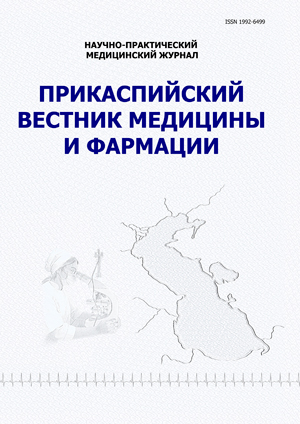
Прикаспийский вестник медицины и фармации / Caspian Journal of Medicine and Pharmacy / Prikaspijskij vestnik mediciny i farmacii
Учредитель журнала: Федеральное государственное бюджетное образовательное учреждение высшего образования «Астраханский государственный медицинский университет» Министерства здравоохранения Российской Федерации (ФГБОУ ВО Астраханский ГМУ Минздрава России), 414000, г. Астрахань, ул. Бакинская, д. 121.
Издательство: ФГБОУ ВО Астраханский ГМУ Минздрава России (http://www.post@astgmu.ru), 414000, г. Астрахань, ул. Бакинская, д. 121.
Типография: редакционно-издательский отдел ФГБОУ ВО Астраханский ГМУ Минздрава России, 414000, г. Астрахань, ул. Бакинская, д. 121.
Распространение: Российская Федерация.
Издается с 2020 года.
Периодичность выхода: 4 раза в год.
Рецензируемый научно-практический журнал «Прикаспийский вестник медицины и фармации» зарегистрирован Федеральной службой по надзору в сфере связи, информационных технологий и массовых коммуникаций 04.03.2020 г. (Свидетельство о регистрации ПИ № ФС77-78002).
Журнал распространяется среди подписчиков, а также в виде целевой рассылки по России, на специализированных конференциях и конгрессах, выставках, семинарах.
Журнал индексируется и архивируется в различных базах и депозитариях: Российской государственной библиотеке, Российской книжной палате, КиберЛенинке, Российской Научной Электронной Библиотеке (Elibrary.ru), Российский научный журнал (РНЖ).
Редакционная коллегия и редсовет журнала состоят из ведущих специалистов России и зарубежья.
Главный редактор: Умерова Аделя Равильевна – доктор медицинских наук, профессор, заведующая кафедрой клинической фармакологии, Астраханский государственный медицинский университет, Астрахань, Россия.
«Прикаспийский вестник медицины и фармации» — это медицинский рецензируемый научно-практический журнал, на страницах, которого публикуются результаты научных исследований клинической и фундаментальной медицины на территории Российской Федерации и за рубежом.
Основные разделы журнала: оригинальные исследования, наблюдения из практики, научные обзоры.
Журнал публикует статьи по следующим направлениям (в соответствии с Приказом Минобрнауки России от 24 февраля 2021 года № 118):
3.1.5. Офтальмология (медицинские науки);
3.1.7. Стоматология (медицинские науки);
3.1.6. Онкология, лучевая терапия (медицинские науки);
3.1.9. Хирургия (медицинские науки);
3.1.13. Урология и андрология (медицинские науки);
3.1.18. Внутренние болезни (медицинские науки);
3.1.21. Педиатрия (медицинские науки);
3.1.24. Неврология (медицинские науки);
3.2.3. Общественное здоровье, организация и социология здравоохранения (медицинские науки);
3.3.2. Патологическая анатомия (медицинские науки);
3.3.6. Фармакология, клиническая фармакология (фармацевтические науки);
3.4.2. Фармацевтическая химия, фармакогнозия (фармацевтические науки);
3.4.1. Промышленная фармация и технология получения лекарств (фармацевтические науки).
В издании представлен уникальный клинический и экспериментальный опыт как практических врачей, так и специалистов разных научных и клинических школ. Публикуются научно-практические статьи для целевой аудитории - врачей различных специальностей.















